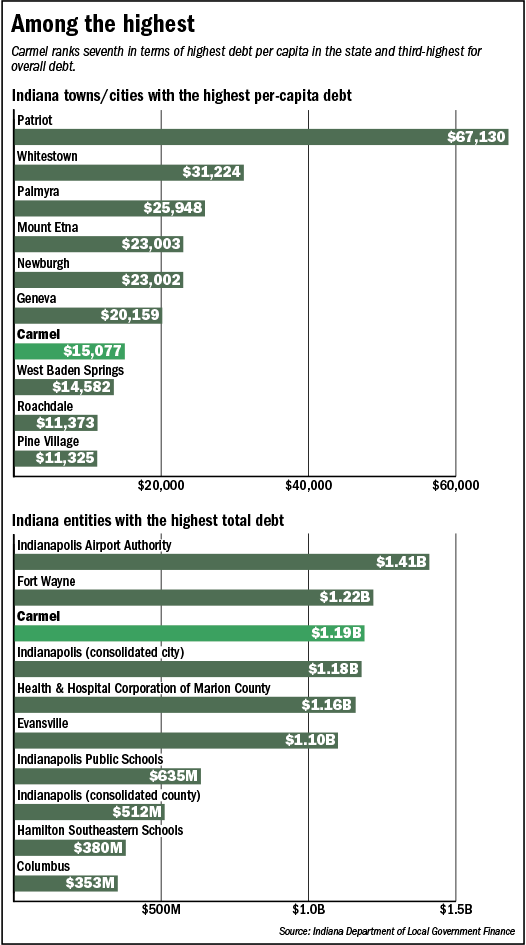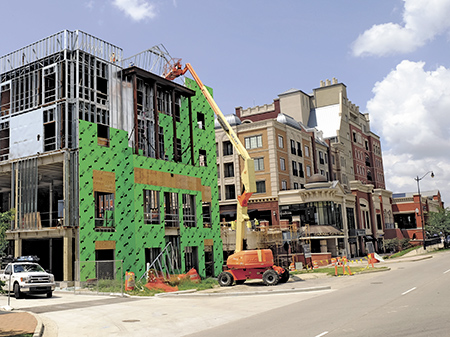Subscriber Benefit
As a subscriber you can listen to articles at work, in the car, or while you work out. Subscribe NowCarmel Mayor Jim Brainard knows his city takes on a lot of debt.
The northern suburb’s total liabilities have swelled to nearly $1.2 billion including principal, interest and other debt payments, according to the Indiana Department of Local Government Finance.
That’s a level Standard & Poor’s—which has given the city the firm’s second-highest credit rating—says is “very high.”
But to the mayor, it’s all worth the cost.
His city’s population has more than doubled over the past two decades, reaching 91,000. Meanwhile, private developers have continued to invest in Carmel’s core, and property taxes have stayed below or close to the rates in neighboring municipalities.
A recent study from the Indiana University Public Policy Institute concluded that Carmel’s use of public dollars has generated economic activity, jobs and additional investment that might not have occurred otherwise.
Now, Brainard wants to add to the debt load again with $101 million in new bonds to build additional roundabouts, invest in infrastructure improvements and add more downtown amenities, including a high-end hotel and antique carousel.
Brainard said all the projects would be funded through two new bonds—one for $76 million and another for $25 million—and would improve Carmel’s quality of life.
That’s important, he said, because if people want to live in Carmel, they’ll want to work in Carmel. And if people want to work in Carmel, the city can more easily attract corporate headquarters, which builds the commercial tax base. Those taxes then help cover the bond payments.
If the City Council approves Brainard’s newly proposed bonds, Carmel will have increased its debt by more than $400 million since the beginning of 2016.
 Johnson
Johnson“I’d say that’s a lot, especially for a city in Indiana,” said Craig Johnson, an associate professor in Indiana University’s School of Public and Environmental Affairs. “Cities in Indiana generally don’t issue a lot of debt.”
In fact, only three others have hit the $1 billion threshold for total outstanding debt, according to the DLGF, which collects financial data from all taxing units.
Fort Wayne has slightly more debt than Carmel, at $1.22 billion. Indianapolis ranks behind Carmel, at $1.18 billion, while Evansville is third, at $1 billion.
Carmel’s existing debt has paid for projects within City Center, including the Palladium. It’s also funded major road improvements, including Keystone Parkway, and covered multiple water and wastewater upgrades.
And Brainard argues Carmel can afford it. He said the spending once again will pay off in terms of spurring economic development and improving quality of life.
 Brainard
Brainard“It is a lot of money, but our revenues are very, very good for a city of this size,” Brainard said. “And there’s no reason to think they would decline in the future.”
Outstanding obligations
Carmel has 48 outstanding bonds, according to information IBJ received from the city and the state. The payments for eight of those bonds are funded with revenue from tax increment financing districts and private developers. That means there is no direct city obligation. Still, the debt is issued in Carmel’s name.
Municipalities use TIF districts to spur development they believe otherwise would not occur. Bonds are paid down using additional property tax revenue generated by the new development.
Payments on another 12 bonds are funded with TIF dollars and backed by other taxes in case that revenue falls short.
 Eight bonds were issued under the name of Carmel Utilities, which has its own budget and is responsible for its own debt.
Eight bonds were issued under the name of Carmel Utilities, which has its own budget and is responsible for its own debt.
The payments for 20 bonds are covered by either property taxes or local income tax revenue from what was formerly known as the county option income tax. Of those, 13 are general obligation bonds—each less than $2 million. Their payments are funded by a special tax rate of about 2 cents per $100 of assessed value that went into effect this year. A bond from 2014 also has a separate tax rate of 4 cents per $100 of assessed value to cover the payments.
Comparing communities
Despite Carmel’s substantial debt, it has maintained an overall tax burden that is lower than that of most surrounding communities, and its total rate decreased about 5 percent this year, to 0.7895 per $100 of assessed value. That rate is projected to increase slightly next year to 0.8022.
Curt Coonrod, a certified public accountant and financial adviser for Carmel, said the city rarely increases taxes to pay for debt because it regularly finds other sources of funding.
“Carmel is unusual in that it doesn’t very often use a special property tax rate to pay bonds,” said Coonrod, who also served two terms on the Indianapolis City-County Council.
Cities must report new debt within one month to the DLGF, the state agency that reviews and approves local tax rates and levies.
According to DLGF records, Carmel owes $1.2 billion—including principal, interest and other debt payments—as of the beginning of the year.
City officials, however, disagree with that figure. The city says its outstanding debt obligation is $881 million—including the proposed $101 million bonds—because the DLGF information is not up to date.
Coonrod said the city’s documents don’t match the DLGF’s public finance database, known as Gateway, because that’s “not Carmel’s website. Carmel doesn’t control it.”
But because all local governments are required to report and update their data with the agency, the DLGF is the most reliable way to track financial information, including bonds, and to compare communities’ finances.
According to DLGF data, Carmel has the third-highest outstanding debt among all Indiana taxing units, behind only the Indianapolis Airport Authority and Fort Wayne.
In Hamilton County, Carmel has far more debt than its neighbors. Fishers has $326 million, Noblesville $310 million, and Westfield $93 million.
Carmel’s per-capita debt is also among the highest in the state, at $15,076.
IU’s Johnson said that, because Carmel is growing and has a healthy tax base, it should be able to meet its payment obligations.
“Per capita really does depend on the wealth of your population, not just the number,” he said. “Carmel has a substantial amount of wealth.”
Carmel’s per-capita debt ranks seventh-highest in the state, and most communities at the top of the list are much smaller. Patriot, with a population of just 208, is No. 1, with $67,130 in per-capita debt, but its liabilities are only $14 million.
Per-capita debt of other Hamilton County cities is much lower. The figure is $4,249 in Fishers, $5,975 in Noblesville, and $3,085 in Westfield.
In the budget?
 So can Carmel afford all the debt? The rating agency Standard & Poor’s suggests the answer is almost certainly yes.
So can Carmel afford all the debt? The rating agency Standard & Poor’s suggests the answer is almost certainly yes.
In its most recent report, issued in June, S&P rated Carmel AA+, just one notch below the highest possible, AAA. It said issuers with AA+ ratings have a “very strong” capacity to meet their obligations.
S&P wasn’t without concerns, however.
“The city’s debt burden is very high, which we view as a major credit weakness,” the report said, noting that the new bonds would push it even higher.
On the other hand, S&P said that much of the debt is paid off from TIF and income tax revenue, “limiting the property tax burden on residential homeowners.”
Experts say there’s no hard limit on what any city can afford. It’s up to investors—who often take their cue from rating agencies—and the private market to make the call.
Drew Klacik, senior policy analyst for the IU Public Policy Institute, compared the process to a couple budgeting to buy a home or a car. The couple might disagree about what they can afford, but ultimately, the bank will decide what it’s willing to loan them.
“In the end, the one definition of too much debt that is kind of official is provided by the market and financial institutions,” Klacik said. “Until you get to that point, it’s just opinions.”
S&P said the risks associated with an issuer rated at Carmel’s level and the risks associated with an issuer rated AAA differ “only to a small degree.” However, experts say securing the top rating would be a worthy goal for Carmel, since it would allow the city to borrow at lower interest rates.
“It seems to be, a city of the wealth and growth of Carmel, they really should be rated AAA,” Johnson said. “I think they could save a significant amount of money if they were rated AAA.”
The data in the fiscal plan prepared by Coonrod shows Carmel can easily make its debt payments for years to come, but some charts don’t include all the city’s existing bonds. For example, the fiscal plan Brainard provided to City Council members includes the proposed $76 million bond that would be paid for with income tax revenue but excludes the proposed $25 million bond backed by TIF revenue.
Coonrod said that’s because the $25 million TIF bond doesn’t affect the general fund.
But other outstanding bonds backed by TIF dollars are referenced in the fiscal plan. Coonrod said those TIF-backed debts have been finalized, whereas the $25 million bond is still tentative.
The fiscal plan also omits debt that is expected to be paid back by developers, because it’s not city-backed debt.
However, a list of outstanding debt prepared by another financial firm employed by the city, H.J. Umbaugh and Associates, does include developer-backed bonds, but does not compare bond payments to revenue sources. That list was also distributed to council members.
Coonrod said the city’s financial documents don’t match because they were prepared at different times, for different reasons and by different financial consultants.
“We do make some effort to coordinate with Umbaugh, particularly on the debt items,” he said. “We don’t want them to be inconsistent. … We just have different objectives and different jobs.”
The state estimates that Carmel’s total debt payments in 2017 will reach more than $54 million and will increase to nearly $58 million in 2018. The peak hits in 2027 when the debt obligation is expected to be more than $68 million, according to the DLGF.
But Carmel’s projections are different.
The fiscal plan prepared by Coonrod shows a debt obligation of $56 million this year and projections through 2024 that peak at $79 million that year.
More spending
The proposed $101 million in new bonds would fund more roundabouts, pedestrian paths, infrastructure improvements and land acquisition for future redevelopment.
It would also pay for an antique carousel, which could cost $5 million and has raised some eyebrows.
“People said, ‘Why do we need a carousel in Carmel?’” Brainard said. “Well, we don’t. Just like we don’t need bike paths. We don’t need parks. We don’t need the Monon Center. We probably don’t need the library. We could choose to be a much lesser city.”
He compared the criticism to the backlash he received when the city decided to build arches around the entrances to the city’s Arts & Design District. Now, he said, people regularly take photos with the arches in the background, and the structures have become a well-known community feature.
Another head-turning project included in the bonds is a $38 million high-end hotel the city would own.
Brainard has been trying to lure an upscale hotel to City Center for 20 years. Brands including Hampton Inn and Courtyard Marriott have been options in the past, but Brainard has been after a five-star facility.
“To be able to attract those corporate headquarters, we need that level of hotel,” Brainard said. “A hotel developer would look at the site and put up an inexpensive hotel. That’s our concern.”
He described the hotel as “vital” to the completion and success of City Center.
Most of those projects would be covered by the $76 million local income tax bond. The city has been much less specific about how the $25 million would be used.
Brainard said it will be used by the Carmel Redevelopment Commission for property acquisition, but he declined to comment about what projects or what specific land the city is pursuing, saying it would harm negotiations.
Johnson said municipalities should be as specific as possible in bond documents so investors know what they’re getting.
“You shouldn’t give governments a blank check basically. People want to know what they’re investing in,” Johnson said. “And it’s good public policy because the citizens need to know. The citizens are responsible for paying back the debt.”•
Please enable JavaScript to view this content.

